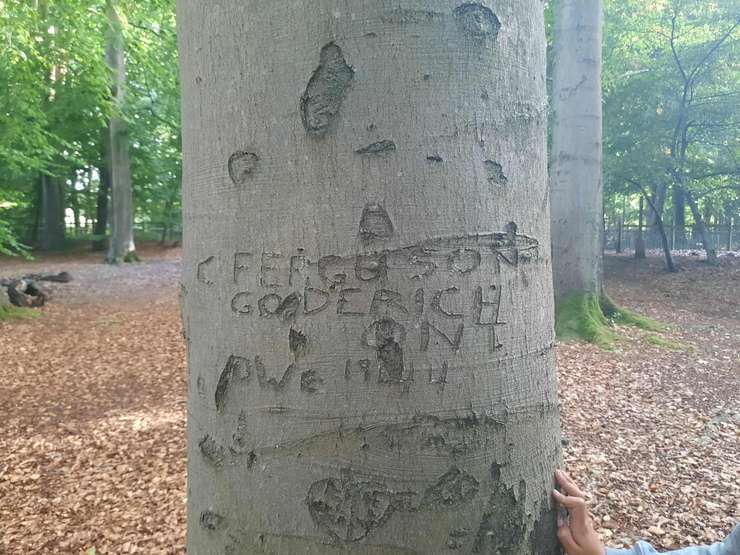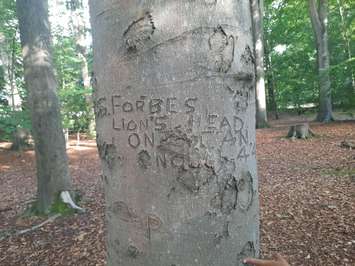As Canadians pause to remember the sacrifices of war this Remembrance Day, an unexpected discovery in a quiet English woodland earlier this year is revealing a powerful connection to Midwestern Ontario, one carved into the bark of old trees more than eighty years ago.
Deep in the woods near Aldershot, England, a town known as the "Home of the British Army" and one of the key assembly points for Allied troops before D-Day, a man named Mark Leslie Ford recently stumbled upon several tree carvings etched by Canadian soldiers in 1944:
“S. FORBES, LION’S HEAD, ONT, CAN, NOV ’44”
and
“C. FERGUSON, GODERICH, ONT, D.W.E. 1944.”
The carvings are located near the juncture of Clubhouse Road and Fleet Road, a wooded area just outside Aldershot, where thousands of Canadian troops trained and camped before crossing the Channel to join the Allied advance in Europe.
Ford, who lives in nearby Rushmoor, says he’s found several trees in the same area marked with Canadian names, hometowns, and dates from 1944. "There’s quite a few trees with inscriptions on them," he said. "We know there were a lot of Canadians in our area at the time."
One of the names, S. Forbes, appears to tie back to Selby Forbes, a Lion’s Head man who served in the Royal Canadian Army Medical Corps during the Second World War. While the connection hasn’t been officially confirmed, members of the Forbes family say the details line up.
In a message shared with CKNXNewsToday.ca, Lorraine Morris, one of Selby’s daughters, recalled stories of her father’s wartime service at Aldershot, where he performed ambulance duties and met his brother Gordon by chance while transporting wounded soldiers. "He never talked much about what he saw over there," she said, "but I do remember his stories about meeting his brother and visiting relatives in Scotland." Morris also noted that a similar carving exists on the family’s first farm in Lindsay Township, possibly made by Selby himself before or after the war, lending further weight to the idea that the Aldershot carving may indeed be his.
For historians, these carvings, known as “arborglyphs,” are more than graffiti. They’re enduring personal records of soldiers facing the uncertainty of war. British archeologist Chantel Summerfield, who has documented thousands of such carvings across England and Europe, has described them as "military graffiti" that capture the emotions and humanity of soldiers during their final days of training before deployment.
While most of the trees studied by Summerfield were found near Salisbury Plain, another major training site for Canadian forces, the Aldershot discoveries represent a new chapter in that story, and a tangible link to Ontario’s own wartime legacy.
During the Second World War, tens of thousands of Canadians passed through Aldershot. The area was a hive of activity in 1943 and 1944, as Canadian divisions prepared for Operation Overlord, the Allied invasion of Normandy. For many, it was their last stop before the front lines.
Eighty-one years later, their initials and hometowns remain, quietly preserved in the English countryside.
For those traveling abroad, the site can be found in the wooded area near Clubhouse Road and Fleet Road in Aldershot, within the Rushmoor district of Hampshire, England, west of the Army Cricket Ground. Locals say the trees are still standing, and the engravings, though faint, can be seen with a careful eye.







